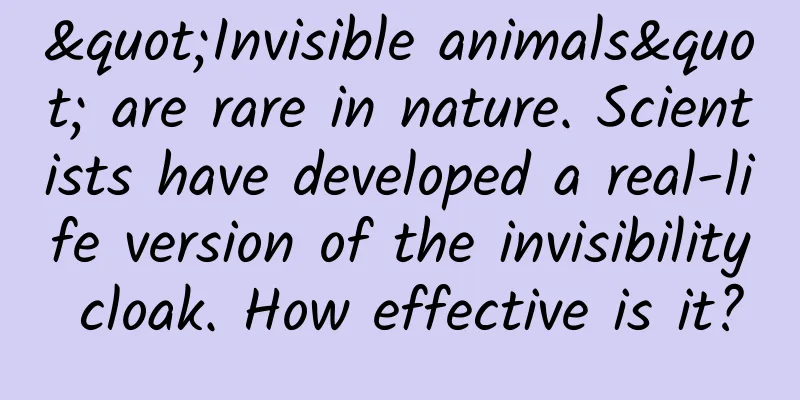"Invisible animals" are rare in nature. Scientists have developed a real-life version of the invisibility cloak. How effective is it?

|
"Invisible animals" are rare in nature. Scientists have developed a real-life version of the invisibility cloak. How effective is it? If you had an invisible cloak, what would you most like to use it for? Can humans really hide perfectly in nature with invisible cloaks? What animals in nature are almost impossible to see through with the naked eye? First, let's take a brief look at the invisible kings in nature. First up, the stick insect. Its body is slender and can be decomposed. It looks almost exactly like bamboo. Its skin is dark brown, green or dark green, so it is as easy for it to imitate bamboo as eating and drinking. During the day, it stays on the branches and can adjust the depth of its color according to the light and temperature. It only comes out at night, so it is difficult for people to find them in life. Second, the orchid mantis. As the name suggests, the mantis does look like an orchid, pink and bright in color, and mainly lives in Southeast Asia. Do you remember what Zhang Wuji's mother said, the more such mantises are, the more likely they are to deceive people? The orchid mantis is no exception. It can adjust its own color according to the depth of the flower color, and can even use its own limbs to fake the structure and color of the petals, just waiting for insects to be attracted to collect nectar, and then it will come up with a sickle. The third animal that is best at camouflage is the leaf butterfly. When it spreads its wings, the brilliant colors are very eye-catching, but when it folds its wings and hides in the dead leaves, you may not be able to find it even with an 8x scope. It is precisely because of this that this stealth skill allows the dead leaf butterfly to avoid being hunted by its natural enemies. Fourth, flounder. The eyes grow on the same side, a typical asymmetrical structure, but this structure is more suitable for lying flat on the seabed, using mud and sand to cover itself, and then just waiting for the arrival of prey. Similarly, flounder can also change its color according to the surrounding environment, and it is difficult to find its trace even if you have a keen eye. Then the question is, have you ever seen an invisible cloak made by humans? After the unremitting efforts of scientists, using objects such as cloaks to avoid the pursuit of the opponent like Harry Potter has gradually become a reality. In general, the invisible cloaks developed by humans can be divided into two main types, one is infrared invisible cloaks, and the other is naked eye invisible cloaks. Let's look at the first one first. German scientists Tolga Ilkin and Nicholas Stenger used a technology called static laser flatbed burning to create invisible material sheets made of micro plastic rods. Because the intervals between these plastic sheets are as small as 0.001 times of a millimeter, they can change the refractive index of the object, thereby affecting the change of light. In the experiment, the researchers covered a raised chip with a piece of invisible material, and then observed it with an infrared camera. They miraculously found that the invisible material and the chip underneath disappeared together. Because the invisible cloak changes the speed of light around the raised part of the chip, refraction will change the visual shape of the three-dimensional object, making the position where the chip is located flat. However, it is worth noting that this invisible material can only make objects appear to disappear under infrared devices, and cannot escape the detection of human eyes. So what can this invisible cloak be used for in real life? It is mainly used on the battlefield. For example, the Defense Advanced Research Projects Agency, the US agency responsible for studying the security of the Pentagon, intends to use invisible cloaks to allow fighter jets to hide in the enemy's radar detection range. As early as May 30, 2017, the Russian Satellite Network reported that Russian special forces had obtained several sets of unique invisible cloaks. It is said that after wearing this cloak, coupled with the camouflage of the night, even if the opponent uses night vision equipment and thermal imaging equipment, they cannot find their traces, which is convenient for the implementation of night combat plans. However, this kind of invisible cloak still needs to be tested by scientists before it can be put into use. Russian experts said that this kind of invisible cloak may be used by snipers and scouts in the future. Next, let's learn about the research on cloaks that can achieve invisibility in front of people's naked eyes. This kind of advanced invisible device, as long as the object is placed behind a multi-layer lens, it will look like it has disappeared out of thin air. It is a 3D invisible technology called Rochester Cloak developed by scientists at the University of Rochester in the United States. However, it is more like a device used by optometrists than a cloak. So what is the principle of this device to make objects invisible? Generally speaking, most invisible cloaks use the principle of light refraction, and the same is true for Rochester Cloak. It refracts the light in the center of the lens through the arrangement and combination of two pairs of lenses with different focal lengths, so as to achieve the effect of making the ring part outside the center of the lens invisible. During the experiment, the researchers put their hands and iron rulers behind the lenses, and they were indeed invisible, leaving only the hands and the background behind the stickers. It is worth mentioning that if this technology is applied to real life, it will be of great use. For example, if such a lens is installed on the back of a large truck, the truck driver can directly see the situation behind the car. In addition, this technology can also bring surprising visual effects to people in military, medical and art design. According to Josephs, who participated in the research, the Rochester cloak is currently the only device in the world that can achieve continuous multi-directional invisibility, and it only costs more than $1,000, equivalent to about 6,750 yuan. The researchers also plan to apply for a patent for this technology. The new silk material that can really be used to make a wearable invisible cloak is the one developed by Professor Fiorenz Obaneto of the United States in 2010. He led the research team to boil the silk and extract the silk protein, and then coated the surface of the material with a layer of gold to refract and distort the wavelength of light to achieve the invisible effect, and the silk material is also very suitable for wear. Unfortunately, such a cloak has not yet been released, and its researchers prefer to use this technology to monitor the recurrence of human cancer. By the way, if an invisibility cloak really comes into the market one day, how much would you be willing to spend to buy it? |
<<: Drinking cold water can make you gain weight, you can find out the bacteria in your intestines
>>: Collect it now! Be careful of this "bomb"!
Recommend
Pigs are still in the spotlight: Why can't Gree make mobile phones?
“Good air conditioner, made by Gree.” With such a...
Don't laugh! Shanxi people really eat dirt
Double 11 has just passed and Double 12 is coming...
I have been using WeChat for so long! I just found out that WeChat Scan function is so powerful. Don’t just use it for payment anymore.
I have been using WeChat for so long! I just foun...
Several methods to implement delayed operation in Android development
Using Handler and Runnable The Handler class can ...
Exclusive interview with Tencent's Liu Yafei: Challenges of mobile game operation and maintenance in complex environments
From 2013 to 2014, the global mobile game market ...
Do goldfish have a positioning system? Scientists have discovered a novel experimental method to unlock the secrets of the human brain's GPS
Goldfish spend most of their time swimming gracef...
Apple offers free replacement program for some iPhone XS, XS Max, and XR smart battery cases
In January 2019, Apple launched a smart battery c...
A heart-breaking suggestion for advertising purchased with a 1 million yuan budget!
People often ask me, which channel is the most ef...
Can correct kneeling method cure the disease caused by sitting out?
Recently, the editor has been complaining about b...
A seagull that always wanted to eat some fries swallowed a cell phone one day
There’s a popular cartoon you must have seen: The...
520 Valentine's Day topic marketing!
Long time no see, everyone. In this episode of 5 ...
How important is deliberate practice? Brain: If you repeat something 10,000 times, you will become an expert in that field!
□ Wang Mingyu In daily life, we often hear the ph...
Ranking China's Internet giants
At the recent World Internet Conference, there wa...
Bojinhui Xiaobai Welfare Online Earning Project, long-term stable monthly income of 5,000
Bojinhui Xiaobai Welfare Online Earning Project, ...
Jellyfish are poisonous, so why are sea cucumbers edible?
I often see netizens say "Most jellyfish are...









